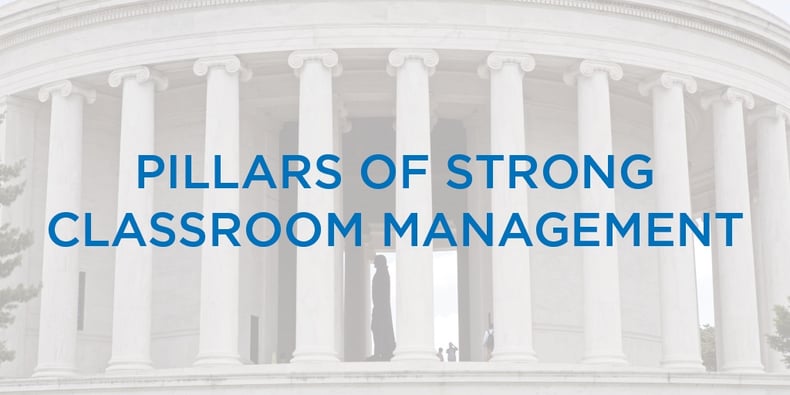
When you look at the Jefferson Memorial, the numerous ionic columns support the giant marble dome, making it look strong and symmetrical. It is an impressive structure—the pillars are all needed in order to make it stand. Without each one of them, the structure would definitely be unstable and could fall.
An architectural structure such as this is a good metaphor for classroom management. The learning, the curriculum, and instruction are the dome. It is the most important part of the entire structure, but it cannot stand without the columns supporting it. Classroom management are the pillars; it supports the entire structure, and each part of it matters.
All teachers, but especially newer teachers, must focus on the pillars. There must be effort and attention given to each of these areas—the best instruction in the world will not matter if there are not strong classroom management practices in place.
Here are the four pillars of classroom management:
- Ownership: The teacher must feel a sense of ownership for the behavior of the students in the classroom. This ownership comes down to a feeling of efficacy. High-efficacy teachers know that their actions shape the culture of the classroom and the climate of student learning. Low-efficacy teachers feel the victim of poor parenting, poor support from administration, and always getting the “worst” students in their class.
Key action step: The classroom teacher must “own” the behavior of the students. If this attitude isn’t present, coaching the teacher would be a good first step. Stephen Covey’s book, The Seven Habits of Highly Effective People, is also a good reference for people who need to understand how to become more effective in what they do.
- Procedures: The teacher must have procedures in place for various classroom tasks. These tasks could include entering the classroom, morning bell work, turning in papers, independent work, group work, dismissing, and lining up, just to name a few. Early in the year and in the teaching career, these are vitally important to have in place in a consistent manner.
Rules could be included in this section as well, but I have found over the years that procedures are actually more important. Procedures help to circumvent problems before they happen, while rules help to support and enforce the overall behavioral philosophies of the classroom teacher. This is important, but not as crucial as having clear and consistent procedures.
Key action step: If procedures are lacking in a classroom, the teacher should pick one of the areas listed above and practice it for at least a week—and more if needed. A week of practice may feel like overkill, but it is crucial for students to know that their teacher will devote as much time as needed to make this happen. Again, the mindset of “ownership” is critical for the teacher to have—they must believe that it is their classroom, and they are responsible for the students being able to know the procedures.
- Relationships: Students who have a strong connection with their teacher learn better and have fewer disruptions to their learning. There is strong research to support this, and it also makes intuitive sense. We have all had teachers or coaches in our life who we have worked harder for because of our connection with them. We did not want to let them down, so we did our very best at all times. This the same for students in our classrooms who know we care about them—they would never want to let us down.
Key action step: Do a self-evaluation inventory or checklist. How well you know your students is a great reflective way to decide if this is an area of strength or an area that needs improvement. Here is an example of a reflective tool that could help you focus on any areas that need improvement.
- Response (positive and negative): Rewards and consequences help to support and encourage student growth with their behavior. This comes last on the list because out of all the pillars, it is probably the least important. With that said, it is still a pillar. There must be structures in place to reinforce the desired and undesired behaviors of students. Without this, students struggle to become motivated to act in the ways that will help them to be successful.
Key action step: If this is an area that needs improvement, focus on the positive reinforcers more than the negative. Determine which behaviors should be increased and which should be decreased, and then tie positive motivators to them. Another important step is to ask students for feedback about what motivates them. Often times, there are simple, free rewards that can be highly effective.
Through all of these steps, teachers can really grow in becoming classroom managers. Don’t forget to check out ways that technology can help to support these challenges—it plays a critical role in both learning and classroom management.
For more insightful teaching tips, and to stay up to date with the current trends in education and education technology, subscribe to our Educator blog today.



